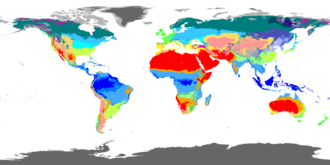Divisions
The Eurasian Steppe extends for 8,000 kilometres (5,000 miles) from the Carpathian Basin to the western edge of Manchuria. It is bounded on the north by the forests of European Russia and Siberia (Asian Russia). There is no clear southern boundary although the land becomes increasingly dry as one moves south.
Pontic–Caspian Steppe
The Pontic–Caspian Steppe is the main European end of the Eurasian Steppe and begins near the mouth of the Danube, stretching northeast almost to Kazan and then southeast to the southern tip of the Ural Mountains. Its northern edge was a broad band of forest steppe which has now been obliterated by the conversion of the whole area to agricultural land. In the southeast the Black Sea–Caspian Steppe extends between the Black Sea and Caspian Sea to the Caucasus Mountains. On the north shore of the Black Sea, the Crimean Peninsula has some interior steppe and ports on the south coast which link the steppe to the civilizations of the Mediterranean basin.
Ural–Caspian Narrowing
The steppe narrows around the southern end of the Ural Mountains, about 650 km (400 mi) northeast of the Caspian Sea, forming the Ural-Caspian Narrowing, that joins the Pontic-Caspian Steppe in Europe with the Kazakh Steppe in Central Asia.
Dzungarian Narrowing
Along the former Sino-Soviet border, mountains extend north almost to the forest zone, separating the Central Steppe from the Eastern Steppe, leaving only limited grassland in Dzungaria. This discontinuous section of the Eurasian steppe connects the great steppes of Central Asia and East Asia.
The east-west Tian Shan Mountains divide the steppe into Dzungaria in the north and the Tarim Basin to the south. Dzungaria is bounded by the Tarbagatai Mountains on the west and the Mongolian Altai Mountains on the east, neither of which is a significant barrier. Dzungaria has good grassland around the edges and a central desert. It often behaved as a westward extension of Mongolia and connected Mongolia to the Kazakh Steppe. To the north of Dzungaria are mountains and the Siberian forest. To the south and west of Dzungaria, and separated from it by the Tian Shan mountains, is an area about twice the size of Dzungaria, the oval Tarim Basin. The Tarim Basin's arid conditions make it unsuitable for sustaining a nomadic population. However, along its periphery, rivers descend from the mountains, creating a circle of cities that thrived on irrigation agriculture and engaged in east-west trade. The Tarim Basin formed an island of near civilization in the center of the steppe. The Northern Silk Road went along the north and south sides of the Tarim Basin and then crossed the mountains west to the Fergana Valley. At the west end of the basin the Pamir Mountains connect the Tian Shan Mountains to the Himalayas. To the south, the Kunlun Mountains separate the Tarim Basin from the thinly peopled Tibetan Plateau.
Mongolian-Manchurian Steppe
The Mongolian-Manchurian Steppe is the main part of the Eurasian Steppe in East Asia. It covers large parts of Mongolia and the Chinese province of Inner Mongolia. The two are separated by a relatively dry area marked by the Gobi Desert. South of the Mongol Steppe is the high and thinly peopled Tibetan Plateau. The northern edge of the plateau is the Gansu or Hexi Corridor, a belt of moderately dense population that connects China proper with the Tarim Basin. The Hexi Corridor was the main route of the Silk Road. In the southeast the Silk Road led over some hills to the east-flowing Wei River valley which led to the North China Plain.
South of the Khingan Mountains and north of the Taihang Mountains, the Mongolian-Manchurian steppe extends east into Manchuria as the Liao Xi steppe. In Manchuria, the steppe grades off into forest and mountains without reaching the Pacific. The central area of forest-steppe was inhabited by pastoral and agricultural peoples, while to the north and east was a thin population of hunting tribes of the Siberian type.
Fauna
Big mammals of the Eurasian steppe were the Przewalski's horse, the saiga antelope, the Mongolian gazelle, the goitered gazelle, the wild Bactrian camel and the onager. [2] [3] [4] [5] [6] [7] The gray wolf, corsac fox, Pallas's cat and occasionally the brown bear are predators roaming the steppe. [8] [9] [10] [11] Smaller mammal species are the Mongolian gerbil, the little souslik and the bobak marmot. [12] [13] [14]
Furthermore, the Eurasian steppe is home to a great variety of bird species. Threatened bird species living there are for example the imperial eagle, the lesser kestrel, the great bustard, the pale-back pigeon and the white-throated bushchat. [15]
The primary domesticated animals raised were sheep and goats with fewer cattle than one might expect. Camels were used in the drier areas for transport as far west as Astrakhan. There were some yaks along the edge of Tibet. The horse was used for transportation and warfare. The horse was first domesticated on the Pontic–Caspian or Kazakh steppe sometime before 3000 BC, but it took a long time for mounted archery to develop and the process is not fully understood. The stirrup does not seem to have been completely developed until 300 AD (see Stirrup, Saddle, Composite bow, Domestication of the horse and related articles).



































